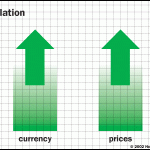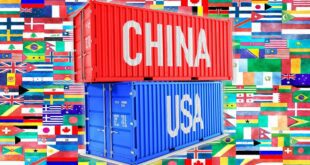This article takes a look at the expected trends in the price of oil, cost of living and currency wars and how they most likely will impact inflation.
currency wars and how they most likely will impact inflation.
The above introductory comments are edited excerpts from an article* by Ronald R. Cooke (tceconomist.blogspot.ca) entitled What Are The Odds in 2015: Inflation or Deflation? – The Case for Inflation.
Cooke goes on to say in further edited excerpts:
Like other central banks, the U. S. Federal Reserve has “printed” copious quantities of money yet, despite better GDP numbers and positive media commentary, much of the American economy continues to be lethargic. The Euro zone appears increasingly vulnerable to recession. Financial and geopolitical risks could derail economic growth.
Oil
The rate of inflation is sensitive to the price we pay for a barrel of oil. Political turmoil in Iraq, Iran and North Africa threatens to decrease potential production. New discoveries are not keeping up with consumption. However, a combination of sluggish world demand, increased American production, and Saudi production strategy, has temporarily depressed oil prices.
There is a fundamental economic problem with fracking. It is capital intensive per barrel of oil produced because even “good” wells deplete very quickly. Depletion rates can exceed 70% in the first year and economic well life can be less than 5 years. That means oil exploration and production companies must recover well capital costs over a relatively short period of time. After accounting for the costs of well production and company operations, it will be a struggle – at current oil prices – for many companies to generate enough cash flow from future production to pay off accumulated debt.
Lower oil prices have also savaged the profitability of oil sands production. According to the International Energy Agency, about 25 percent of the synthetic crude produced from the sands is no longer profitable at $80 per barrel.
It is difficult to understand how one can predict increased oil production from fracking or sands at current oil prices. This conflict of revenue versus cost is not sustainable. Unless there is an unlimited amount of junk bond debt available, aggregate production will decrease. Speculation will quickly drive up the price of Brent and WTI crude.
Conclusion: Expect oil price inflation in 2015. Current expense items –such as food and fuel – are extremely vulnerable to the price of oil.
Government
Public debt financing, along with entitlement and contract obligations, will force Federal and State government administrations to increase taxes. Look for increases in investment, estate, property, income, sales, and corporate taxes.
The idea that only incomes over $200,000 ($250,000 for married couples) will be taxed is a politically expedient myth. Every worker will pay more personal income taxes. All consumers (including welfare recipients) will pay more direct and indirect taxes when they purchase goods and services. The cost of living goes up. That’s inflation.
- Medical care continues to be a critical driver of inflation. Obamacare, Medicare, and Medicaid costs are out of control. Individual premiums will skyrocket in 2015.
- College, university, high school and grammar school costs will continue to escalate at rates that exceed the base rate of inflation despite the growing availability of competitive on-line education,
- Proposed state and Federal Environmental Protection Agency (EPA) rules will raise the price of goods and services for all consumers and businesses resulting in continuing increases in the cost of doing business while decreasing economic growth.
- State and Federal regulation of employment, welfare, business, banking, and consumer activity continues to increase the cost of doing business. Lawmakers typically ignore the economic damage. Businesses that manage to survive will have to raise the prices they charge for the goods and services they sell.
Conclusion: government bureaucracy and regulation will be a primary source of inflation in 2015.
Banks
- Central bank financial policy has not resulted in a sustained economic recovery, witness the declining fortunes of Western Europe and the declining financial condition of the American family (except for the very rich).
- Printing copious amounts of money (paper and electronic) has increased national debt burdens.
- It could be argued low interest rates are actually impeding economic activity because money is flowing into financial instruments (including rank speculation) rather than business building financing instruments.
- The health of the stock market is an illusion.
…Monetary accommodation (lower interest rates and public spending) can stimulate aggregate final demand – BUT – only if these stimulus funds flow into private commercial activity, the consumer has manageable debt burdens, and families have (at least the hope of) increasing real income. There is no money multiplier if the consumer is broke, and small businesses are unable to secure loans. It is people, after all, who make investment decisions including personal time, personal risk and personal money. It is government bureaucrats, on the other hand, who always bury economic activity under the pile of excessive regulatory restrictions, and it is politicians who will make politically expedient spending decisions without regard for the eventual financial consequences. These are structural problems that will forever trash the Keynes monetary management thesis.
Which brings us to the value of money: the cocktail circuit likes to talk about dollar deflation, as though the declining value of the dollar is deflationary. For democrats and liberals, such talk may be politically correct and politically expedient, but it is based on a deliberate perversion (or outright ignorance) of economic reality. When the value of the dollar (or Yen, or Euro, or …) goes down (deflates) the price of goods and services that can be purchased with that dollar goes up.
We know national governments make a huge effort to obfuscate the rate of inflation (because inflation hurts the proletariat), but if the article I bought yesterday cost $1.00, and today it costs $1.10, that’s inflation. Anytime the dollar devalues, the price we pay for goods and services goes up. That’s inflation.
Some central banks are suggesting the devaluation of their national currency in order to compete with the (declining) value of other national currencies. The easiest way to accomplish their objective will be to print money. If a currency war breaks out, there is no upper limit to the rate of inflation.
Conclusion: Central banks, particularly in Europe and the United States, have created a pile of debt. The winds of economics will bring in higher interest rates and currency devaluation. It’s all inflationary.
Editor’s Note: The author’s views and conclusions in the above article are unaltered and no personal comments have been included to maintain the integrity of the original post. Furthermore, the views, conclusions and any recommendations offered in this article are not to be construed as an endorsement of such by the editor.
*http://www.tceconomist.blogspot.ca/2014/10/what-are-odds-in-2015-inflation-or.html
If you liked this article then “Follow the munKNEE” & get each new post via
- Our Newsletter (sample here)
- Twitter (#munknee)
Related Articles:
1. We Will Experience the Anguish of Severe Inflation In the Coming Years – Here’s Why
The Fed’s buying of U.S. Treasuries by creating currency (paper money) out of thin air is inflationary (either now or long term) and those that do not accept this premise are, with all due respect, daft, and is sure to result in a momentous growth in the value of hard assets such as gold and silver. Here’s why. Read More »
2. Inflation Will Become a Huge & Growing Problem Beginning In 2015 – Here’s Why
A temporary period of deflation will result from the end of the Fed’s massive asset purchases followed by a period of inflation that will make the ’70s seem like an era of hard money. Here’s why. Read More »
3. High Inflation IS Coming – It’s Just A Question Of When – Here’s Why
There have been many econoblog posts of the form, “ha, ha, the people predicting inflation have been wrong so far, when will they give up?”. Let me try to explain why we know high inflation is coming eventually. Read More »
4. Inflation or Deflation: Are We Approaching the Tipping Point?
Might our Inflation-Deflation Watch be suggesting a breakout in asset price inflation is about to take place? Could it, in fact, be presaging the start of John William’s hyper inflationary depression in which prices rise exponentially even in light of massive unemployment and bankruptcies? This article analyzes the situation. Read More »
5. there is no inflation, There is No Inflation, THERE IS NO INFLATION! Yeah, Sure!
Don’t listen to what the official numbers say. Inflation is a big problem already for the U.S. economy – and in an inflationary environment, gold bullion goes up and stock prices go down, because materials cost more and consumers spend less. I’d adjust my portfolio accordingly for the rapid inflation that awaits us. Read More »
6. Inflation: What You Need to Know
The March year-over-year inflation rate was 1.51%, which is well below the 3.88% average since the end of the Second World War and 37% below its 10-year moving average. Read More »
7. 15 Questions & Answers Regarding Hyperinflation
It is difficult to say exactly when hyperinflation will hit a currency. However, I am convinced that the danger level is so high for most fiat money that it is worthwhile for everyone to increase their understanding of hyperinflation. This is the first part of a Hyperinflation FAQ for frequently asked questions or objections about hyperinflation. Words: 1600 Read More »
8. Debt Default or Hyperinflation? Which Will It Be?
The Fed, together with other central banks from around the world, have created the perfect crescendo of worldwide credit bubbles and asset bubbles leading to the excesses and decadence which are the normal finale to a secular trend. They have totally destroyed all major world currencies and left the world with debts that cannot and will not be repaid with normal money. As such, there are only two alternative outcomes, debt default or hyperinflation. Both will have disastrous consequences for the world economy. Read More »
 munKNEE.com Your Key to Making Money
munKNEE.com Your Key to Making Money


